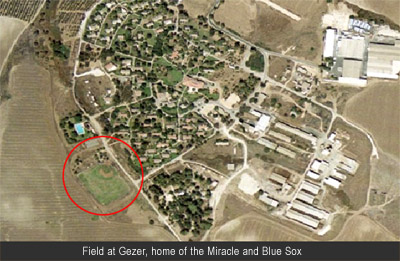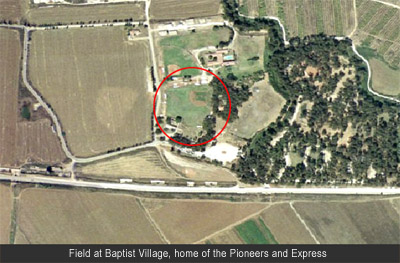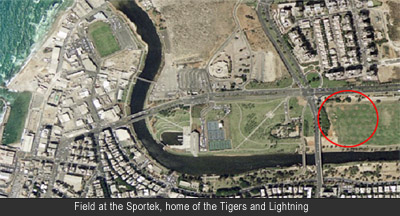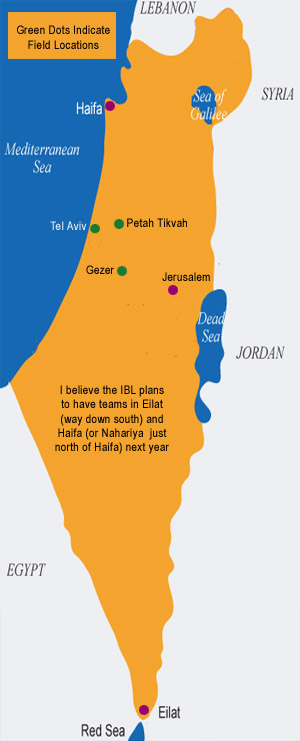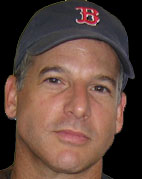Why is playing baseball in Israel meaningful to me?
Let me explain...
Grandpa and Baseball My grandfather, Abraham Alexenberg, was a pitcher and his big brother Ben was a catcher. When I was twelve years old I asked Grandpa if he ever hit a guy with a pitch, and if the batter charged the mound. He said it happened once but Ben, who was strong as an ox, was the catcher and grabbed the batter before he could get very far. Grandpa told me that Ben always took care of him. I wondered how amazing it must have been for the brothers to share a ball field and the game they love.
Grandpa was born in Woodbine New Jersey in 1906 and lived there until he was an adult. He was six foot three and had a large frame. His father, my great grandfather, immigrated to the USA from Odessa in the Ukraine to escape the pogroms. I never met my great grandfather, but I am told he was taller than my grandfather. I saw him in a few pictures standing very proud, looking strong and handsome. Woodbine was a small agricultural village of Jewish immigrants. Grandpa was one of eight children. He had four brothers and three sisters. He was the second to youngest. The brothers all played baseball.

My grandfather played semi pro ball and was offered a pro contract with the Brooklyn Robins but bursitis in his shoulder, the low pay for pro ball players and the tough life the minor leagues presented for a Jew in the 1920’s made his decision to pursue dentistry the more practical choice. As it turned out, the great depression came and he was forced to abandon ambitions of an education to make an immediate living. Around 1980, I went with grandpa to visit Burke, one of his older brothers. Burke must have been around 80 years old and was blind. As we left, I hugged Burke goodbye and he held my arm and told me that back in the day Grandpa was one hell of a ballplayer. My grandfather overheard and declined the compliment saying it was Burke that was the best of the brothers. I still love imagining what it must have been like, a bunch of brothers playing baseball in a small Jewish immigrant farming town.
Grandpa was a quiet man and extremely modest. I would ask him about his baseball playing days and he would typically respond with one sentence. I could never get a conversation going. But he loved to play catch with me and regularly showed me how to throw a knuckleball. He also enjoyed watching baseball on TV and took me to many Met and Yankee games.

I have fragmented memories of games. I remember Grandpa pointing out Harmon Killebrew when the Twins were at Yankee stadium. I also remember Roy White scoring a run in that game. Another time, after a post game subway ride we took a long walk through the city streets of New York. It was late in the afternoon on a warm summer day we were on our way to a deli. Just Grandpa and me, I had a Pastrami sandwich.
Israel and Holland When I was almost eight years old my family moved to Israel and shortly thereafter my grandparents moved to Florida. On our way to Israel in the summer of 1969 we stopped in Holland for a few days. My mother’s family is Dutch and my aunt, uncle and cousins lived in Amsterdam.

My great great grandfather, Rabbi Yosef Tzvi Dunner , was the chief rabbi of Holland. Most of my mother’s side of the family were murdered in the Holocaust. It was in those few days that I was first exposed to the horrors of the Holocaust. My uncle’s parents gave him to a gentile family so that he would survive the Holocaust. He was four years old and spent most of his time in silence in an attic living on left over foods like potato peels. I asked my father why Mom’s family didn’t just leave Holland before the Nazi’s got them. He explained that they believed Hilter was a madman contained in Germany, and that his insane ideas would never come to fruition.
As the plane approached Israel the passengers began to sing joyous Hebrew songs. This did not happen when we landed in Holland. When the wheels touched the ground my mother burst into tears. It was scary and I asked my father why mom was crying. With an intense look and a few words he conveyed to me that we just completed a journey, not of a few hours ride from Europe but of a couple thousand years from the four corners of the earth back to our homeland.
During that week I experienced a Jewish history lesson that permanently instilled in me the depth of value that Israel has to the Jewish people. Anyone who reads the ancient Jewish texts will repeatedly be reminded that Israel has always been the Jewish homeland. But it became real and practical the second we landed. Most European Jews had no place to escape the Nazi's. Many of the surviving members of my mothers family now lived in Israel. Israel is the hope realized; a strong nation with a growing economy, bustling with innovations founded on a deep functioning democracy.

Rabbi Shlomo Zalman Kahn, my great great grandfather (on my fathers side), left the Telz Yeshiva in Lithuania to attend the Fourth Zionist Congress in 1900 in London. He never returned, after his studies in London and Paris he moved to Boston and eventually opened a Hebrew book store on Coney Island Ave in Brooklyn. My family has a letter in Yiddish written by him telling of his experience at the zionist congress. To him Israel was a dream for me it is a dream come true.
Baseball, Israel and Grandpa 
During my “Little League years” between the ages of eight and twelve I lived in Israel. Though there was no baseball in Israel back then, I would often throw a tennis ball against stone walls and field the erratic bounces pretending I was making great plays. When I was almost twelve years old we moved back to the states for four years. I spent every opportunity playing stickball with my best friend Yitzie. We were observant Jews and because Yeshiva ended late and we could not play on the Sabbath we did not have the opportunity to play in organized leagues.
My love of the game never waned and the summer I turned 24 years old I decided to tryout for an amateur league in Boston. I could fill a book with the trials and tribulations I endured learning how to pitch as an adult in competitive leagues. Eventually, I learned that it took more than throwing a good fastball somewhere around the plate to succeed at a high level. Unfortunately, by the time I figured out how to harness my talent, I had a family to support and was “too old” to pursue a pro career. I continued coaching and playing over the years. I played ball and coached from little league through division one college ball at San Diego State University, one of the best programs in the country.

When I was told that a pro baseball league was starting in Israel I felt excited but then the cruel irony gripped me. I had missed the opportunity to play pro ball because I grew up in Israel before baseball was being played there and when I returned to the states I could not play because games were played on the Sabbath. Now there was a pro league in Israel that does not play games on the Sabbath and I seemed too old to play. In a further irony, the first tryouts were being held in Massachusetts, a mere couple hour drive from my home. My wife, as she did as my girlfriend over 20 years earlier, encouraged me to tryout. Though I knew I could still pitch at a high level I told her it was ridiculous, that they would never consider a 45 year old. The tryouts came and went. When I heard that the next tryouts were being held in Petah Tikvah, ten minutes from where my parents and two siblings live, I started feeling like the universe was giving me signs. I was being given a second chance to play the game I love, in a country I love. If I did not at least go to a tryout, I would regret it the rest of my life. My father understood what was happening and called to tell me he was booking a flight to Israel for me. On a beautiful day on a ball field in the center of the country I pitched my heart out. Dan Duquette, the past general manager of the Boston Red Sox was watching and it was he who would decide if I was worthy of a contract. After completing my tryout Dan sat next me in the dugout and asked me a few questions. A few days later I received an email congratulating me on making the cut! If anyone told me a year ago I would be playing professional baseball in Israel and would be signed by Dan Duquette I would have laughed at the adsurdity. Life truly is stranger than fiction.

I possess both an Israeli and American passport. I was told I would need to play under my Israeli passport for tax reasons. I had not seen my Israeli passport in many years, finding it would require a major search. After looking in the attic for quite a while I finally found it resting in a folder with an old relic from my childhood. The relic was a printed roster from a spring training game that my grandfather took me to in Florida in 1974. Though I was only 13 years old, I remember that day like it was yesterday. Jim Mason, a no power, light hitting shortstop for the Yankees hit a 400 foot homerun and Walt “No Neck” Williams made a spectacular catch in the outfield. I kept that roster because on the back I had received the autographs of two old time greats, Roger Peckinpaugh, the American League MVP in 1925 and Hall of Fame member Phil “The Scooter” Rizzuto. I turned the roster over to see who played that day and the first name that caught my eye was Ron Blomberg. I will be sure to bring the roster to Israel this summer for Ron Blomberg to autograph. Ron will be a manager in the Israel Baseball League, he might be my manager. I wish my grandfather was still alive. I can only wonder how he would have enjoyed seeing me share a ball field and the game I love with Ron Blomberg.
 One of the aspects of sports that I love is once a team walks between the lines of the field all players are equal. It matters not whether the person is rich or poor, black or white, Christian or Jew. They become one unit with a common cause, they work together to achieve the same goal. As a coach or player, I don’t know anything about the socio economic background of my players or teammates, it is irrelevant. Ties to the world all melt away on the ball field. During games the only world that exists is the world contained by the chalk lines and the nine innings (or seven in the case of the IBL). The world beyond the game is temporarily suspended.
One of the aspects of sports that I love is once a team walks between the lines of the field all players are equal. It matters not whether the person is rich or poor, black or white, Christian or Jew. They become one unit with a common cause, they work together to achieve the same goal. As a coach or player, I don’t know anything about the socio economic background of my players or teammates, it is irrelevant. Ties to the world all melt away on the ball field. During games the only world that exists is the world contained by the chalk lines and the nine innings (or seven in the case of the IBL). The world beyond the game is temporarily suspended.





